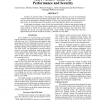89
Voted
IACR
2011
14 years 7 days ago
2011
Abstract. In this paper, we analyze the security of AZUMI protocol which is compliant with the EPCClass-1 Generation-2 standard and recently has been proposed by Peris et al. This ...
131
Voted
JOC
2011
14 years 7 months ago
2011
In light of the growing complexity of cryptographic protocols and applications, it becomes highly desirable to mechanize — and eventually automate — the security analysis of p...
115
Voted
IJNSEC
2011
14 years 7 months ago
2011
In this paper, we reinvestigate the security analysis of blind signature scheme over braid groups proposed by Verma in 2008. A blind signature scheme is a cryptographic primitive ...
SP
2002
IEEE
15 years 7 days ago
2002
IEEE
As networks become faster there is an emerging need for security analysis techniques that can keep up with the increased network throughput. Existing network-based intrusion detec...
99
Voted
IJBC
2006
15 years 17 days ago
2006
In recent years, a large amount of work on chaos-based cryptosystems have been published. However many of the proposed schemes fail to explain or do not possess a number of featur...
111
click to vote
LISA
2004
15 years 2 months ago
2004
Analysis of network traffic is becoming increasingly important, not just for determining network characteristics and anticipating requirements, but also for security analysis. Sev...
113
Voted
ACSAC
2001
IEEE
15 years 4 months ago
2001
IEEE
Software component technology facilitates the costeffective development of specialized applications. Nevertheless, due to the high number of principals involved in a component-str...
101
Voted
CCS
2006
ACM
15 years 4 months ago
2006
ACM
In this paper, we position the correct way of using graphical models for enhancing cyber security analysis in enterprise networks. Graphical models can be powerful in representati...
102
click to vote
FC
2005
Springer
15 years 6 months ago
2005
Springer
Approximate Message Authentication Code (AMAC) is a recently introduced cryptographic primitive with several applications in the areas of cryptography and coding theory. Briefly s...
133
click to vote
ESAS
2005
Springer
15 years 6 months ago
2005
Springer
Abstract. In this paper, we propose a framework for the security analysis of on-demand, distance vector routing protocols for ad hoc networks, such as AODV, SAODV, and ARAN. The pr...



